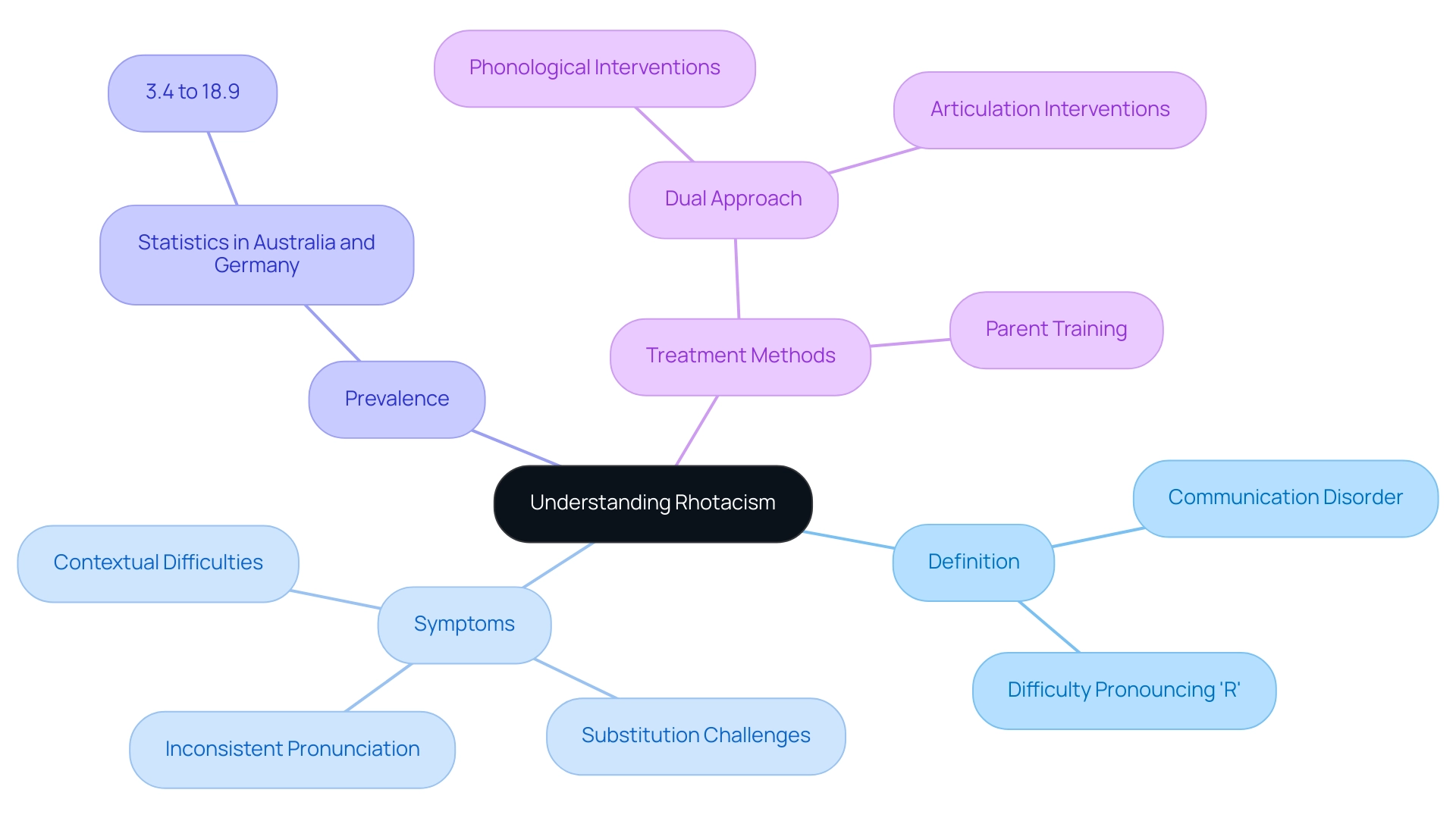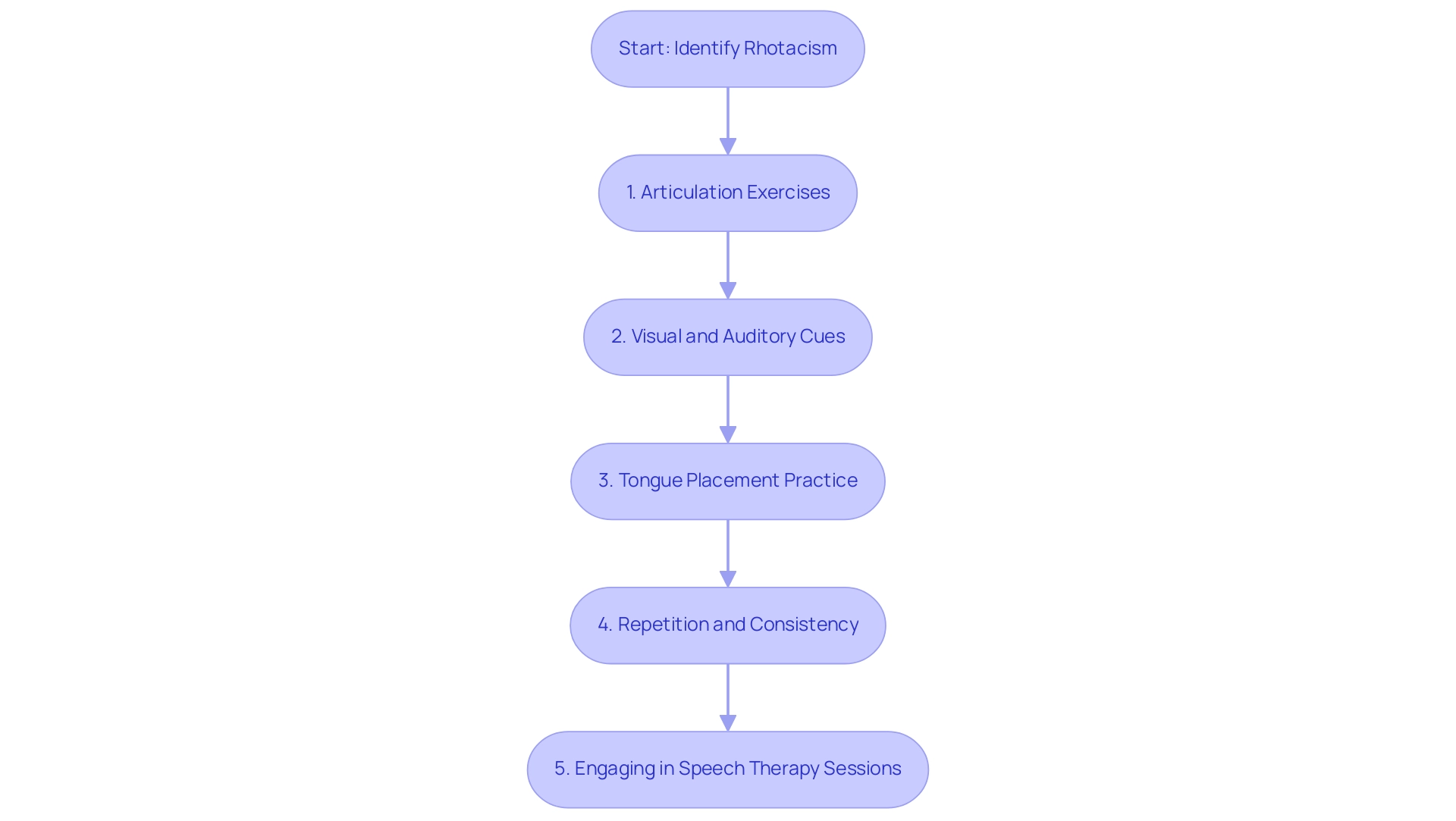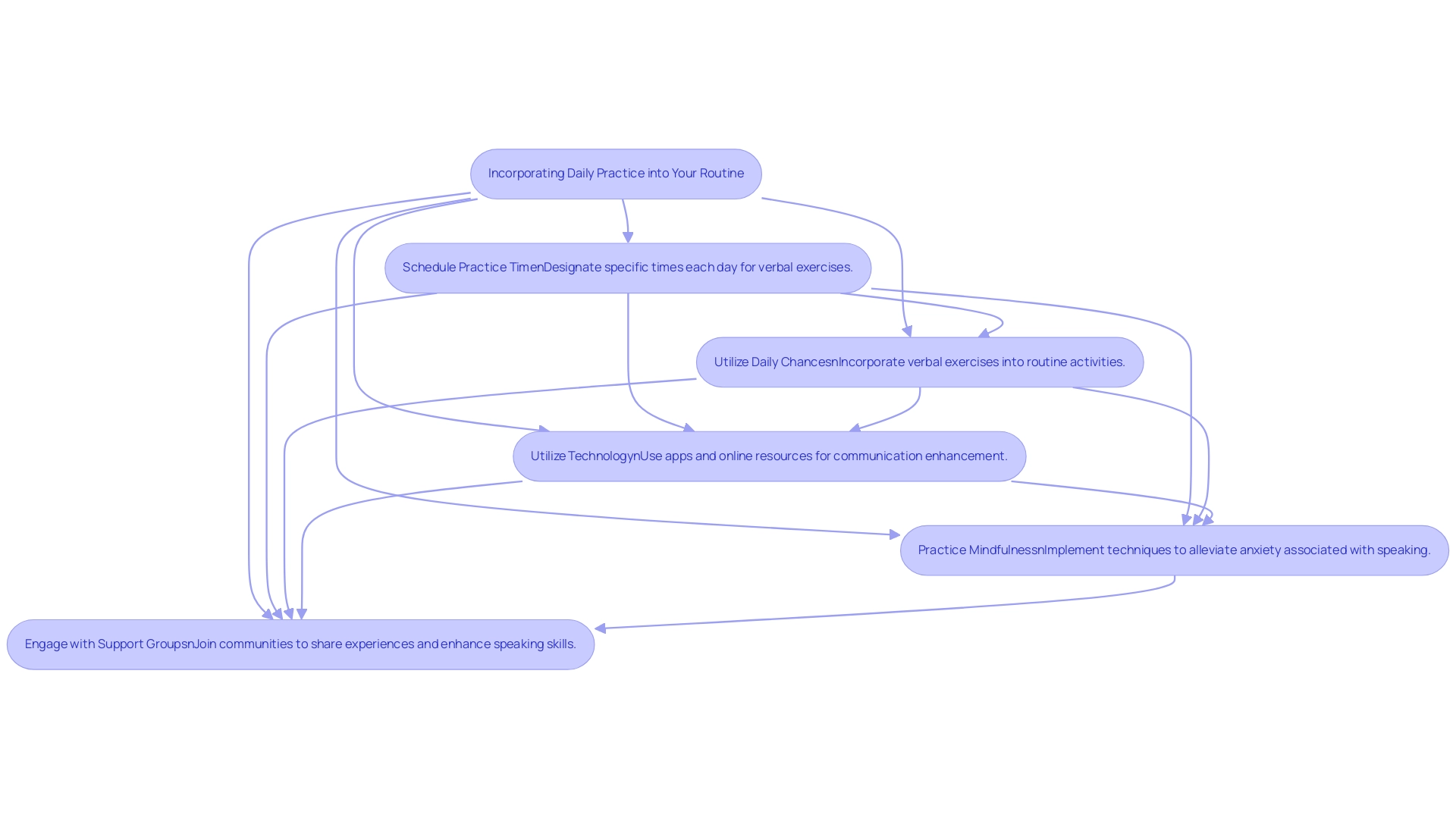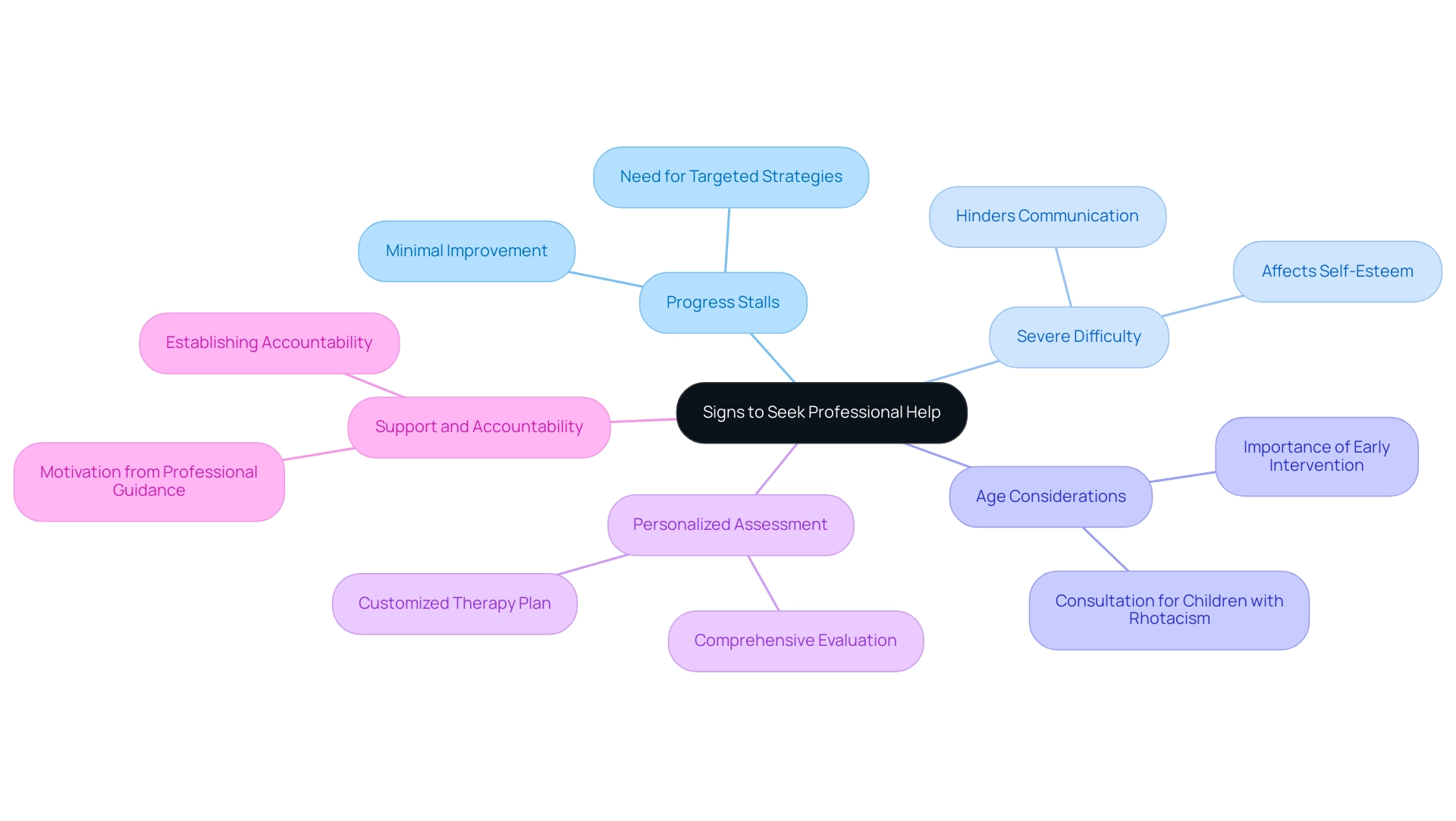Introduction
Rhotacism, a speech disorder characterized by difficulty in articulating the 'r' sound, poses challenges for many individuals, particularly children. This condition often leads to the substitution of 'r' with phonemes like 'w' or 'l', creating speech patterns that can be difficult for others to understand. The prevalence of such disorders is significant, affecting a notable percentage of children across various regions. Understanding the symptoms and implications of rhotacism is essential for early identification and intervention.
This article delves into:
- Effective speech therapy techniques
- The importance of setting realistic goals
- Strategies for incorporating daily practice into routines
Additionally, it highlights when to seek professional help, ensuring that individuals receive the support they need to improve their communication skills and overall quality of life.
1. Understanding Rhotacism: Definition and Symptoms
Rhotacism refers to a specific type of communication disorder characterized by difficulties in pronouncing the 'r' phoneme. Individuals affected by this condition often substitute the 'r' phoneme with others such as 'w' or 'l', leading to speech patterns that may be challenging for others to understand. The prevalence of spoken language disorders, particularly rhotacism, is noteworthy, with studies indicating that among children aged 7 to 11 years in Australia and Germany, the occurrence of such disorders ranges from 3.4% to 18.9%.
Common symptoms of rhotacism include:
- Inconsistent pronunciation of 'r' sounds across different words.
- Frequent substitution of 'r' with pronunciations resembling 'w' or 'l'.
- Challenges in producing the 'r' sound in various contexts, including at the start or end of words.
Recognizing these symptoms is crucial for identifying and addressing rhotacism, facilitating timely interventions through vocal rehabilitation. Effective verbal intervention can significantly improve communication abilities, emotional well-being, academic achievement, and social interactions in children. As Janaina dos Santos Coelho observed, 'the disharmony of the maxillomandibular osseous bases results in interference in acoustic characteristics regarding fricative sounds,' emphasizing the acoustic challenges encountered by individuals with communication disorders.
Furthermore, the case study named '
Mixed Sound Disorders' demonstrates the intricacy of communication disorders, highlighting the need for a dual method in treatment that combines both phonological and articulation interventions to provide complete assistance for the child.
2. Effective Speech Therapy Techniques for Overcoming Rhotacism
-
Articulation Exercises: Begin by practicing the 'r' pronunciation in isolation, progressing to its incorporation into syllables and words. For instance, start with simple words like 'row' and gradually move to more complex phrases.
-
Visual and Auditory Cues: Utilize visual aids, such as diagrams illustrating optimal mouth positioning, alongside auditory cues, like recordings demonstrating correct pronunciations. These tools strengthen learning and assist in creating a clear understanding of audio production.
-
Tongue Placement Practice: Concentrate on proper tongue placement, particularly for sounds that require a slight backward curl of the tongue, such as the 'r' sound. This concentrated exercise is critical for achieving articulation accuracy.
-
Repetition and Consistency: Consistent practice is vital for progress. Allocate dedicated time each day for these exercises, aiming for a minimum of 15-20 minutes to reinforce muscle memory and improve articulation skills. As emphasized by Kaipa & Peterson, more frequent service often leads to greater enhancement in verbal accuracy.
-
Engaging in Speech Therapy Sessions: Collaborate with a certified speech-language pathologist who can provide tailored guidance and monitor your progress. Their expertise is invaluable in developing personalized strategies for addressing rhotacism. A case study titled 'Rhotacism Treatment' illustrates that effective language intervention can significantly enhance the ability to articulate the 'r' phoneme, thereby improving overall verbal clarity and fostering better social and educational integration.
By consistently using these techniques, individuals can improve their capability to articulate the 'r' phoneme, resulting in clearer expression and enhanced communication. As highlighted by specialists, regular practice and engagement with communication professionals often relate to substantial improvements in articulation accuracy, showcasing the efficacy of organized treatment methods.
3. Setting Realistic Goals for Speech Improvement
Setting achievable objectives is a fundamental aspect of effective communication treatment for handling stammering. Here are essential steps to create meaningful objectives:
- Assess Current Abilities: Begin by evaluating your existing speech capabilities, focusing on specific areas of difficulty related to rhotacism, such as the articulation of the 'r' phoneme. Insights from caregivers and educators can help identify strengths and areas for growth in social communication, emotional regulation, daily routines, and literacy, which are essential for planning therapy goals.
- Define Short-Term Goals: Formulate attainable short-term goals, such as mastering the concept of rhotacism in one-syllable words within a month. Setting goals with a target accuracy of 30%, 40%, or 50% can provide a balanced challenge while remaining achievable.
- Establish Long-Term Goals: Develop long-term objectives that encompass broader aspects of communication, aiming to improve overall clarity and confidence in verbal expression, especially in relation to rhotacism. The case study titled "Using Rubrics for Goal Setting" advocates for a nuanced assessment of progress, allowing for more tailored goal-setting approaches that go beyond traditional metrics.
- Monitor Progress: Maintain a journal to document progress towards these goals. Celebrating small victories can significantly enhance motivation and commitment to the treatment process. Incorporating play and sensory activities, as suggested by a speech-language pathologist, can make this monitoring more dynamic and engaging.
- Adjust Goals as Needed: Flexibility is crucial. If a particular goal becomes overly challenging, it is important to modify it to ensure it remains within reach.
By establishing clear, attainable objectives, individuals can enhance their involvement in communication sessions and realize significant progress over time. The combination of play and sensory activities into treatment sessions not only makes the process enjoyable but also reinforces the skills being developed.
4. Incorporating Daily Practice into Your Routine
Integrating daily exercises into your routine can greatly improve your therapy efforts. In fact, seventy-nine percent of speech-language pathologists (SLPs) reported always or often assessing pragmatics, highlighting the importance of integrating application into everyday life. Here are some effective strategies to consider:
-
Schedule Practice Time: Designate specific times each day for verbal exercises, treating these sessions as non-negotiable appointments to ensure consistency.
-
Utilize Daily Chances: Incorporate verbal exercises into routine activities, such as reading aloud, singing, or participating in discussions with friends and family.
This approach utilizes natural interactions to reinforce skills.
-
Utilize Technology: Take advantage of various apps and online resources designed for communication enhancement.
Many of these tools offer interactive exercises and tracking features, allowing for personalized progress monitoring. The influence of technology on communication support results has been substantial, offering new opportunities for application and involvement.
-
Practice Mindfulness: Implement mindfulness techniques to alleviate anxiety associated with speaking. This can enhance clarity and bolster confidence in communication.
-
Engage with Support Groups: Joining support groups or online communities can be beneficial, as these platforms allow you to share experiences and enhance your speaking skills with others who face similar challenges.
The emphasis on caregiver training in therapeutic settings, as highlighted in the case study on service delivery models, supports the notion that family involvement can enhance the effectiveness of these interventions. PE has noted the importance of Therapy Outcome Measures in assessing progress, underscoring the effectiveness of these strategies.
By incorporating verbal exercises as a consistent aspect of your life, you can strengthen the skills acquired in therapy and promote ongoing advancement, ultimately assisting in the application of new vocabulary into daily conversation.
5. Seeking Professional Help: When to Consult a Speech Therapist
While self-directed training can yield benefits, certain situations necessitate the involvement of a professional. It is advisable to consult a speech therapist if the following conditions arise:
-
Progress Stalls: Should you notice minimal or no improvement despite consistent practice, a therapist can provide targeted strategies and insights tailored to individual needs.
-
Severe Difficulty: If challenges in pronouncing the 'r' sound significantly hinder daily communication or affect self-esteem, seeking professional support becomes imperative.
-
Age Considerations: Early intervention is vital for children. If a child shows signs of rhotacism, it is essential to prompt consultation with a language therapist to effectively address the issue. As noted by the Illinois Test of Psycholinguistic Abilities (ITPA), "The ITPA is designed to measure how well children between the ages of 4 and 8 acquire and use language," highlighting the importance of early language acquisition.
-
Personalized Assessment: A qualified therapist can perform a comprehensive evaluation to identify specific challenges and devise a customized therapy plan that caters to the individual's needs.
-
Support and Accountability: Professional guidance not only provides motivation but also establishes accountability, which is crucial for sustained improvement.
Recognizing these signs enables individuals to take proactive measures toward enhancing their speech with the support of a qualified professional. Furthermore, research indicates that only 17.6% of children receive adequate developmental stimulation, underscoring the necessity for active parental involvement and professional intervention in fostering essential language skills. For instance, the case study titled "Coping Strategies for Language Development" illustrates how parents and caregivers can support language development through strategies such as engaging in play, modeling language, and reading together, which can complement professional help.
Additionally, communication disorders are notably more prevalent among non-Hispanic black children and boys, emphasizing the urgency and relevance of seeking professional assistance.
Conclusion
Rhotacism presents significant challenges for individuals, particularly children, impacting their ability to articulate the 'r' sound effectively. This article has outlined the key aspects of understanding rhotacism, including its definition, symptoms, and the prevalence of speech disorders among children. Effective speech therapy techniques, such as articulation exercises and the use of visual and auditory cues, are essential for improving articulation and fostering clearer communication.
Setting realistic goals plays a crucial role in the therapeutic process. By assessing current abilities and defining both short-term and long-term objectives, individuals can track their progress and stay motivated. Incorporating daily practice into routines further enhances the effectiveness of therapy, with strategies that engage everyday interactions and leverage technology for continuous learning.
Lastly, recognizing when to seek professional help is vital for ensuring proper intervention and support. Early consultation with a speech therapist is essential, especially when progress stalls or when severe difficulties arise. The combination of structured therapy, supportive practices, and professional guidance creates a comprehensive approach to overcoming rhotacism, ultimately leading to improved communication skills and a better quality of life. By addressing these elements, individuals can navigate the challenges of rhotacism and achieve significant speech improvement.



































